Management in Information Technology Report: Accenture Analysis
VerifiedAdded on 2020/01/28
|15
|4842
|203
Report
AI Summary
This report provides a comprehensive analysis of IT management practices within Accenture. It begins by outlining the staff recruitment policy, emphasizing equality, diversity, and inclusion, and then delves into motivational theories such as Hertzberg's two-factor theory and Maslow's hierarchy, alongside change management strategies. The report then explores staff administration documentation, highlighting its role in legal compliance and employee management. Furthermore, it examines system management tools like Centage, Prophix, Scoro, and Float, assessing their application in financial reporting and project management. The report concludes by discussing the role of IT in strategic planning, emphasizing its impact on innovation and overcoming challenges. The report covers the role of IT in strategic planning and associated issues.
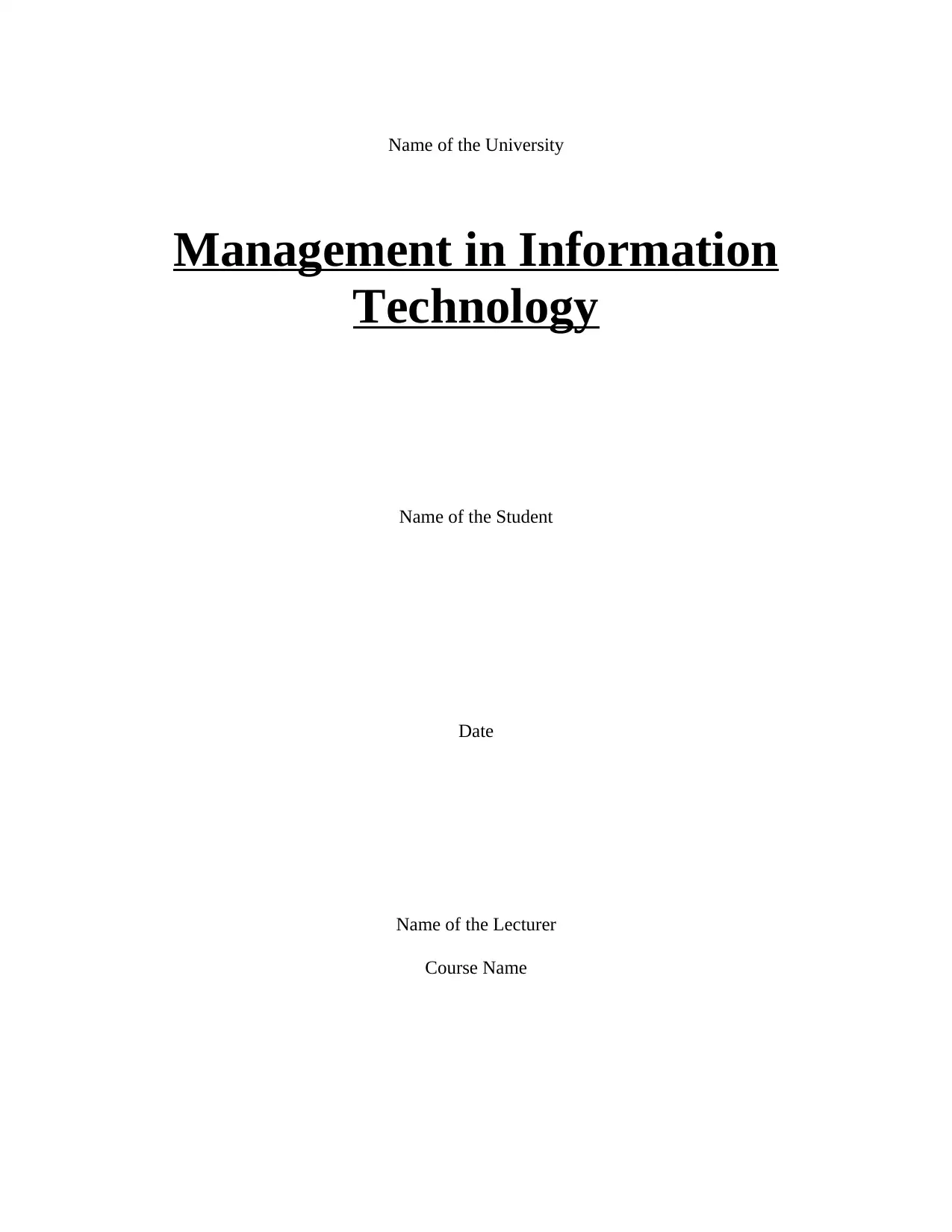
Name of the University
Management in Information
Technology
Name of the Student
Date
Name of the Lecturer
Course Name
Management in Information
Technology
Name of the Student
Date
Name of the Lecturer
Course Name
Paraphrase This Document
Need a fresh take? Get an instant paraphrase of this document with our AI Paraphraser
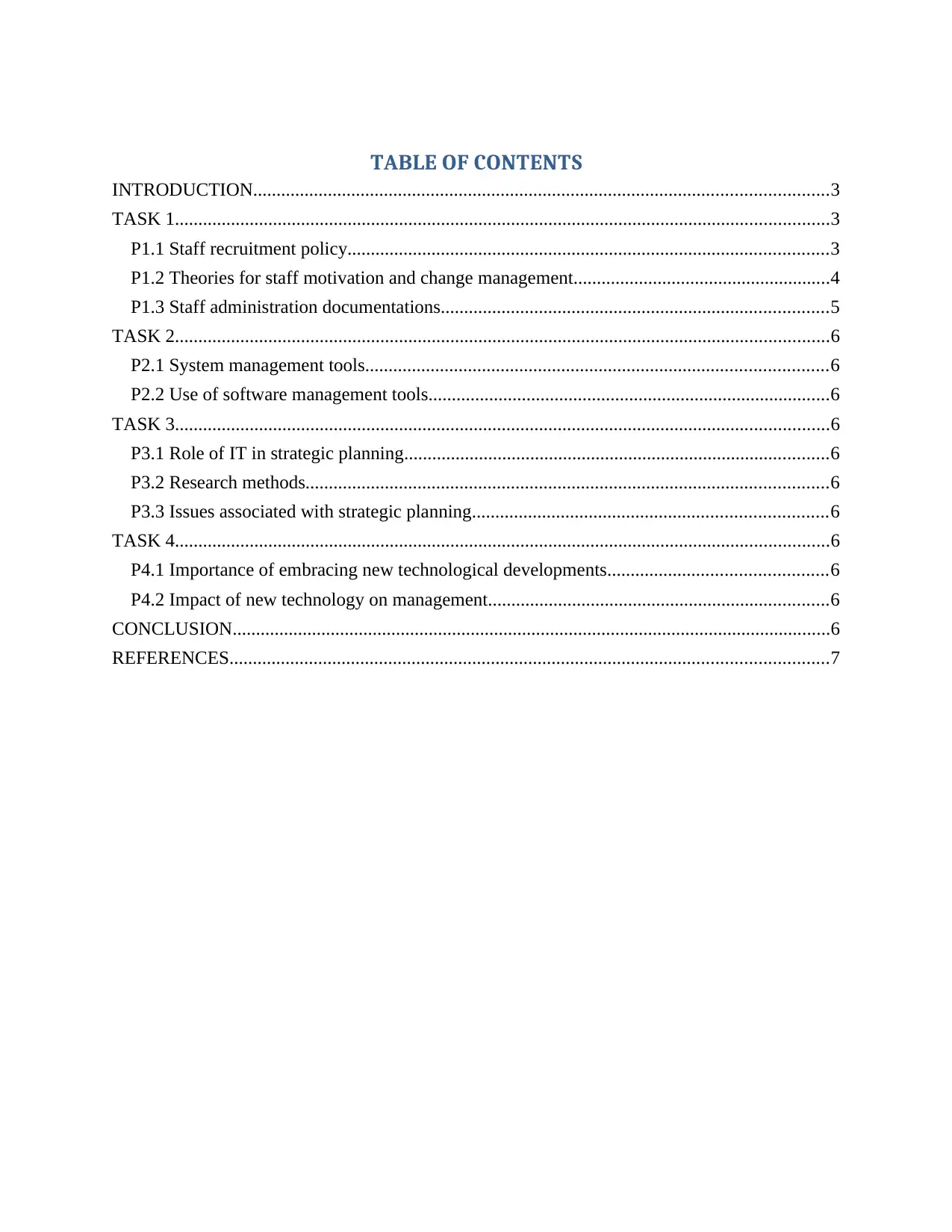
TABLE OF CONTENTS
INTRODUCTION...........................................................................................................................3
TASK 1............................................................................................................................................3
P1.1 Staff recruitment policy.......................................................................................................3
P1.2 Theories for staff motivation and change management.......................................................4
P1.3 Staff administration documentations...................................................................................5
TASK 2............................................................................................................................................6
P2.1 System management tools...................................................................................................6
P2.2 Use of software management tools......................................................................................6
TASK 3............................................................................................................................................6
P3.1 Role of IT in strategic planning...........................................................................................6
P3.2 Research methods................................................................................................................6
P3.3 Issues associated with strategic planning............................................................................6
TASK 4............................................................................................................................................6
P4.1 Importance of embracing new technological developments...............................................6
P4.2 Impact of new technology on management.........................................................................6
CONCLUSION................................................................................................................................6
REFERENCES................................................................................................................................7
INTRODUCTION...........................................................................................................................3
TASK 1............................................................................................................................................3
P1.1 Staff recruitment policy.......................................................................................................3
P1.2 Theories for staff motivation and change management.......................................................4
P1.3 Staff administration documentations...................................................................................5
TASK 2............................................................................................................................................6
P2.1 System management tools...................................................................................................6
P2.2 Use of software management tools......................................................................................6
TASK 3............................................................................................................................................6
P3.1 Role of IT in strategic planning...........................................................................................6
P3.2 Research methods................................................................................................................6
P3.3 Issues associated with strategic planning............................................................................6
TASK 4............................................................................................................................................6
P4.1 Importance of embracing new technological developments...............................................6
P4.2 Impact of new technology on management.........................................................................6
CONCLUSION................................................................................................................................6
REFERENCES................................................................................................................................7
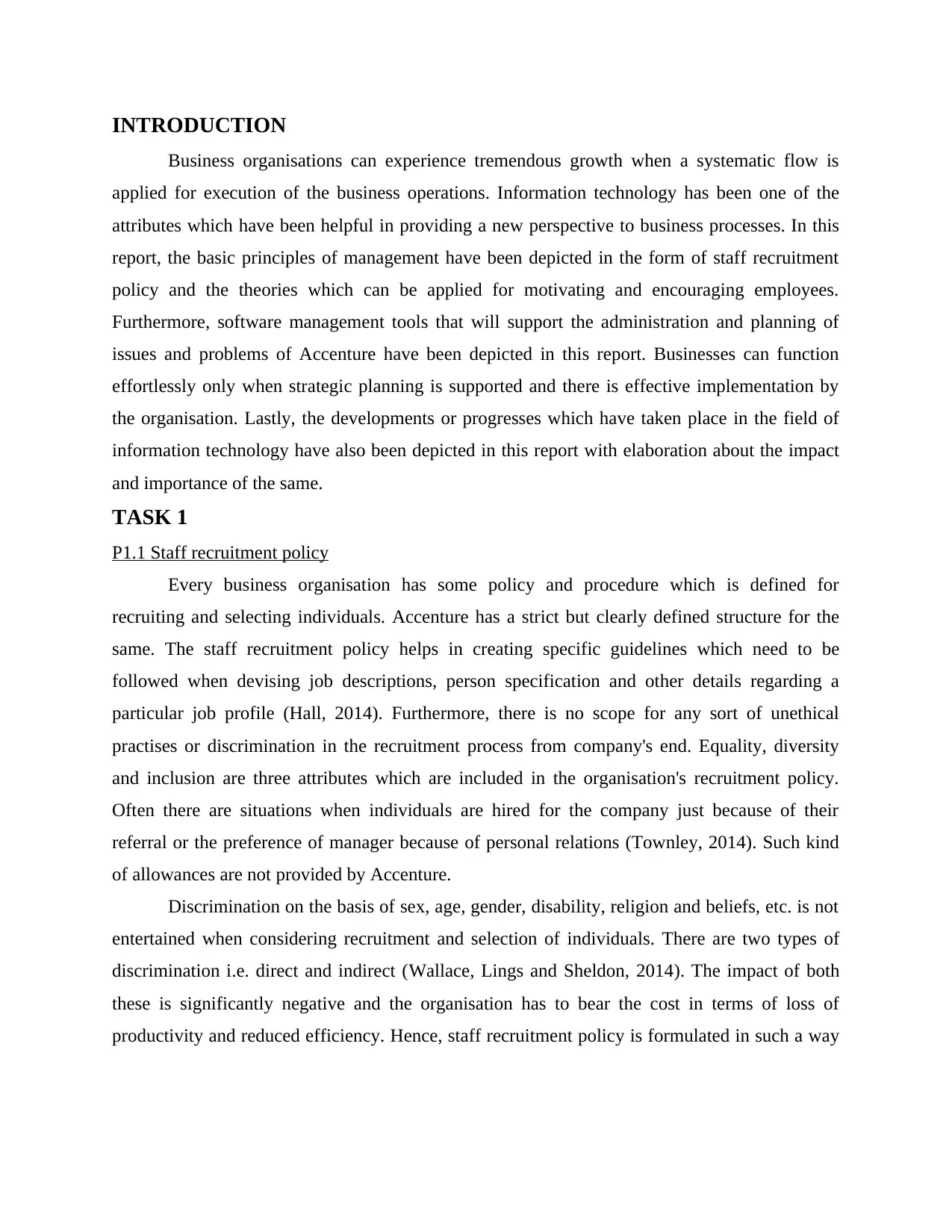
INTRODUCTION
Business organisations can experience tremendous growth when a systematic flow is
applied for execution of the business operations. Information technology has been one of the
attributes which have been helpful in providing a new perspective to business processes. In this
report, the basic principles of management have been depicted in the form of staff recruitment
policy and the theories which can be applied for motivating and encouraging employees.
Furthermore, software management tools that will support the administration and planning of
issues and problems of Accenture have been depicted in this report. Businesses can function
effortlessly only when strategic planning is supported and there is effective implementation by
the organisation. Lastly, the developments or progresses which have taken place in the field of
information technology have also been depicted in this report with elaboration about the impact
and importance of the same.
TASK 1
P1.1 Staff recruitment policy
Every business organisation has some policy and procedure which is defined for
recruiting and selecting individuals. Accenture has a strict but clearly defined structure for the
same. The staff recruitment policy helps in creating specific guidelines which need to be
followed when devising job descriptions, person specification and other details regarding a
particular job profile (Hall, 2014). Furthermore, there is no scope for any sort of unethical
practises or discrimination in the recruitment process from company's end. Equality, diversity
and inclusion are three attributes which are included in the organisation's recruitment policy.
Often there are situations when individuals are hired for the company just because of their
referral or the preference of manager because of personal relations (Townley, 2014). Such kind
of allowances are not provided by Accenture.
Discrimination on the basis of sex, age, gender, disability, religion and beliefs, etc. is not
entertained when considering recruitment and selection of individuals. There are two types of
discrimination i.e. direct and indirect (Wallace, Lings and Sheldon, 2014). The impact of both
these is significantly negative and the organisation has to bear the cost in terms of loss of
productivity and reduced efficiency. Hence, staff recruitment policy is formulated in such a way
Business organisations can experience tremendous growth when a systematic flow is
applied for execution of the business operations. Information technology has been one of the
attributes which have been helpful in providing a new perspective to business processes. In this
report, the basic principles of management have been depicted in the form of staff recruitment
policy and the theories which can be applied for motivating and encouraging employees.
Furthermore, software management tools that will support the administration and planning of
issues and problems of Accenture have been depicted in this report. Businesses can function
effortlessly only when strategic planning is supported and there is effective implementation by
the organisation. Lastly, the developments or progresses which have taken place in the field of
information technology have also been depicted in this report with elaboration about the impact
and importance of the same.
TASK 1
P1.1 Staff recruitment policy
Every business organisation has some policy and procedure which is defined for
recruiting and selecting individuals. Accenture has a strict but clearly defined structure for the
same. The staff recruitment policy helps in creating specific guidelines which need to be
followed when devising job descriptions, person specification and other details regarding a
particular job profile (Hall, 2014). Furthermore, there is no scope for any sort of unethical
practises or discrimination in the recruitment process from company's end. Equality, diversity
and inclusion are three attributes which are included in the organisation's recruitment policy.
Often there are situations when individuals are hired for the company just because of their
referral or the preference of manager because of personal relations (Townley, 2014). Such kind
of allowances are not provided by Accenture.
Discrimination on the basis of sex, age, gender, disability, religion and beliefs, etc. is not
entertained when considering recruitment and selection of individuals. There are two types of
discrimination i.e. direct and indirect (Wallace, Lings and Sheldon, 2014). The impact of both
these is significantly negative and the organisation has to bear the cost in terms of loss of
productivity and reduced efficiency. Hence, staff recruitment policy is formulated in such a way
⊘ This is a preview!⊘
Do you want full access?
Subscribe today to unlock all pages.

Trusted by 1+ million students worldwide
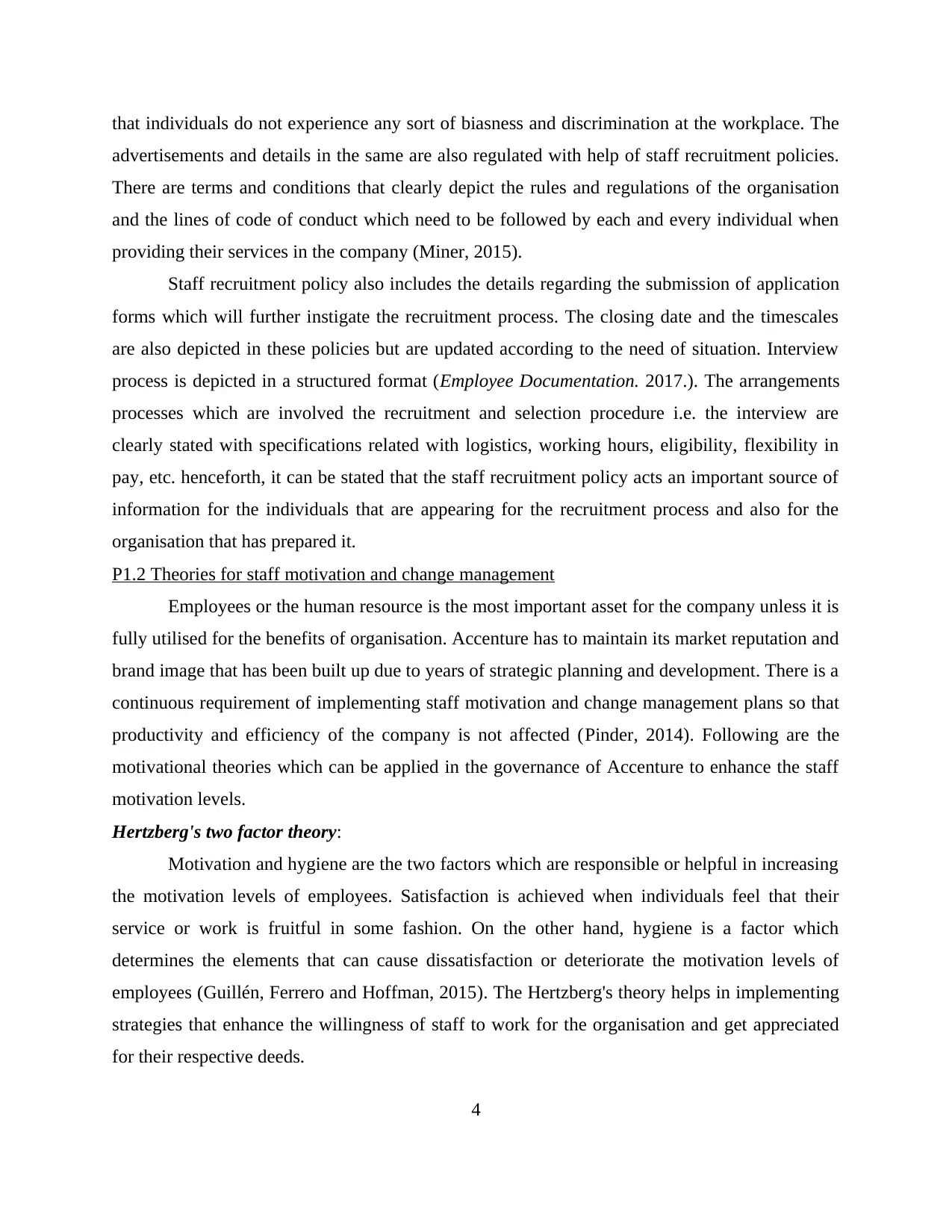
that individuals do not experience any sort of biasness and discrimination at the workplace. The
advertisements and details in the same are also regulated with help of staff recruitment policies.
There are terms and conditions that clearly depict the rules and regulations of the organisation
and the lines of code of conduct which need to be followed by each and every individual when
providing their services in the company (Miner, 2015).
Staff recruitment policy also includes the details regarding the submission of application
forms which will further instigate the recruitment process. The closing date and the timescales
are also depicted in these policies but are updated according to the need of situation. Interview
process is depicted in a structured format (Employee Documentation. 2017.). The arrangements
processes which are involved the recruitment and selection procedure i.e. the interview are
clearly stated with specifications related with logistics, working hours, eligibility, flexibility in
pay, etc. henceforth, it can be stated that the staff recruitment policy acts an important source of
information for the individuals that are appearing for the recruitment process and also for the
organisation that has prepared it.
P1.2 Theories for staff motivation and change management
Employees or the human resource is the most important asset for the company unless it is
fully utilised for the benefits of organisation. Accenture has to maintain its market reputation and
brand image that has been built up due to years of strategic planning and development. There is a
continuous requirement of implementing staff motivation and change management plans so that
productivity and efficiency of the company is not affected (Pinder, 2014). Following are the
motivational theories which can be applied in the governance of Accenture to enhance the staff
motivation levels.
Hertzberg's two factor theory:
Motivation and hygiene are the two factors which are responsible or helpful in increasing
the motivation levels of employees. Satisfaction is achieved when individuals feel that their
service or work is fruitful in some fashion. On the other hand, hygiene is a factor which
determines the elements that can cause dissatisfaction or deteriorate the motivation levels of
employees (Guillén, Ferrero and Hoffman, 2015). The Hertzberg's theory helps in implementing
strategies that enhance the willingness of staff to work for the organisation and get appreciated
for their respective deeds.
4
advertisements and details in the same are also regulated with help of staff recruitment policies.
There are terms and conditions that clearly depict the rules and regulations of the organisation
and the lines of code of conduct which need to be followed by each and every individual when
providing their services in the company (Miner, 2015).
Staff recruitment policy also includes the details regarding the submission of application
forms which will further instigate the recruitment process. The closing date and the timescales
are also depicted in these policies but are updated according to the need of situation. Interview
process is depicted in a structured format (Employee Documentation. 2017.). The arrangements
processes which are involved the recruitment and selection procedure i.e. the interview are
clearly stated with specifications related with logistics, working hours, eligibility, flexibility in
pay, etc. henceforth, it can be stated that the staff recruitment policy acts an important source of
information for the individuals that are appearing for the recruitment process and also for the
organisation that has prepared it.
P1.2 Theories for staff motivation and change management
Employees or the human resource is the most important asset for the company unless it is
fully utilised for the benefits of organisation. Accenture has to maintain its market reputation and
brand image that has been built up due to years of strategic planning and development. There is a
continuous requirement of implementing staff motivation and change management plans so that
productivity and efficiency of the company is not affected (Pinder, 2014). Following are the
motivational theories which can be applied in the governance of Accenture to enhance the staff
motivation levels.
Hertzberg's two factor theory:
Motivation and hygiene are the two factors which are responsible or helpful in increasing
the motivation levels of employees. Satisfaction is achieved when individuals feel that their
service or work is fruitful in some fashion. On the other hand, hygiene is a factor which
determines the elements that can cause dissatisfaction or deteriorate the motivation levels of
employees (Guillén, Ferrero and Hoffman, 2015). The Hertzberg's theory helps in implementing
strategies that enhance the willingness of staff to work for the organisation and get appreciated
for their respective deeds.
4
Paraphrase This Document
Need a fresh take? Get an instant paraphrase of this document with our AI Paraphraser
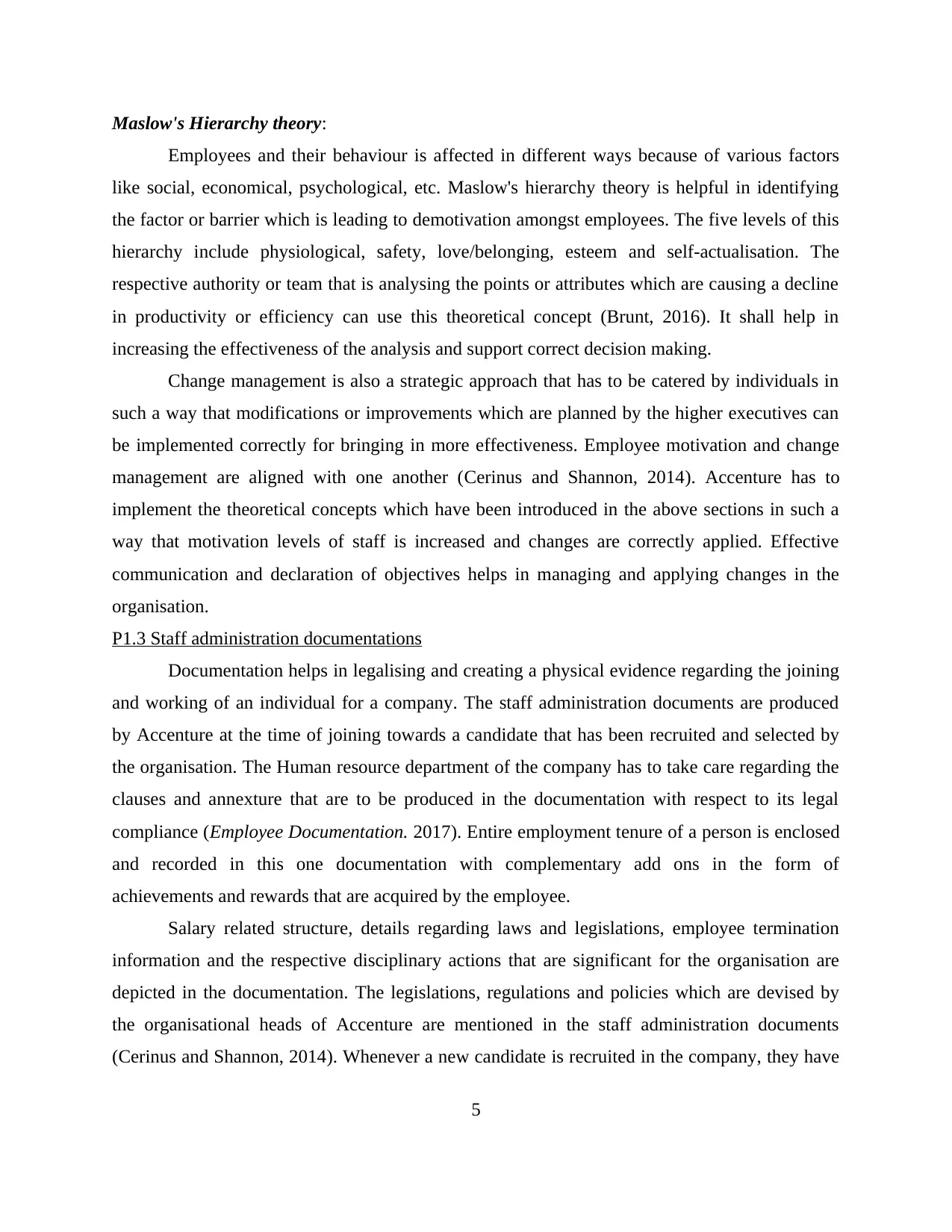
Maslow's Hierarchy theory:
Employees and their behaviour is affected in different ways because of various factors
like social, economical, psychological, etc. Maslow's hierarchy theory is helpful in identifying
the factor or barrier which is leading to demotivation amongst employees. The five levels of this
hierarchy include physiological, safety, love/belonging, esteem and self-actualisation. The
respective authority or team that is analysing the points or attributes which are causing a decline
in productivity or efficiency can use this theoretical concept (Brunt, 2016). It shall help in
increasing the effectiveness of the analysis and support correct decision making.
Change management is also a strategic approach that has to be catered by individuals in
such a way that modifications or improvements which are planned by the higher executives can
be implemented correctly for bringing in more effectiveness. Employee motivation and change
management are aligned with one another (Cerinus and Shannon, 2014). Accenture has to
implement the theoretical concepts which have been introduced in the above sections in such a
way that motivation levels of staff is increased and changes are correctly applied. Effective
communication and declaration of objectives helps in managing and applying changes in the
organisation.
P1.3 Staff administration documentations
Documentation helps in legalising and creating a physical evidence regarding the joining
and working of an individual for a company. The staff administration documents are produced
by Accenture at the time of joining towards a candidate that has been recruited and selected by
the organisation. The Human resource department of the company has to take care regarding the
clauses and annexture that are to be produced in the documentation with respect to its legal
compliance (Employee Documentation. 2017). Entire employment tenure of a person is enclosed
and recorded in this one documentation with complementary add ons in the form of
achievements and rewards that are acquired by the employee.
Salary related structure, details regarding laws and legislations, employee termination
information and the respective disciplinary actions that are significant for the organisation are
depicted in the documentation. The legislations, regulations and policies which are devised by
the organisational heads of Accenture are mentioned in the staff administration documents
(Cerinus and Shannon, 2014). Whenever a new candidate is recruited in the company, they have
5
Employees and their behaviour is affected in different ways because of various factors
like social, economical, psychological, etc. Maslow's hierarchy theory is helpful in identifying
the factor or barrier which is leading to demotivation amongst employees. The five levels of this
hierarchy include physiological, safety, love/belonging, esteem and self-actualisation. The
respective authority or team that is analysing the points or attributes which are causing a decline
in productivity or efficiency can use this theoretical concept (Brunt, 2016). It shall help in
increasing the effectiveness of the analysis and support correct decision making.
Change management is also a strategic approach that has to be catered by individuals in
such a way that modifications or improvements which are planned by the higher executives can
be implemented correctly for bringing in more effectiveness. Employee motivation and change
management are aligned with one another (Cerinus and Shannon, 2014). Accenture has to
implement the theoretical concepts which have been introduced in the above sections in such a
way that motivation levels of staff is increased and changes are correctly applied. Effective
communication and declaration of objectives helps in managing and applying changes in the
organisation.
P1.3 Staff administration documentations
Documentation helps in legalising and creating a physical evidence regarding the joining
and working of an individual for a company. The staff administration documents are produced
by Accenture at the time of joining towards a candidate that has been recruited and selected by
the organisation. The Human resource department of the company has to take care regarding the
clauses and annexture that are to be produced in the documentation with respect to its legal
compliance (Employee Documentation. 2017). Entire employment tenure of a person is enclosed
and recorded in this one documentation with complementary add ons in the form of
achievements and rewards that are acquired by the employee.
Salary related structure, details regarding laws and legislations, employee termination
information and the respective disciplinary actions that are significant for the organisation are
depicted in the documentation. The legislations, regulations and policies which are devised by
the organisational heads of Accenture are mentioned in the staff administration documents
(Cerinus and Shannon, 2014). Whenever a new candidate is recruited in the company, they have
5
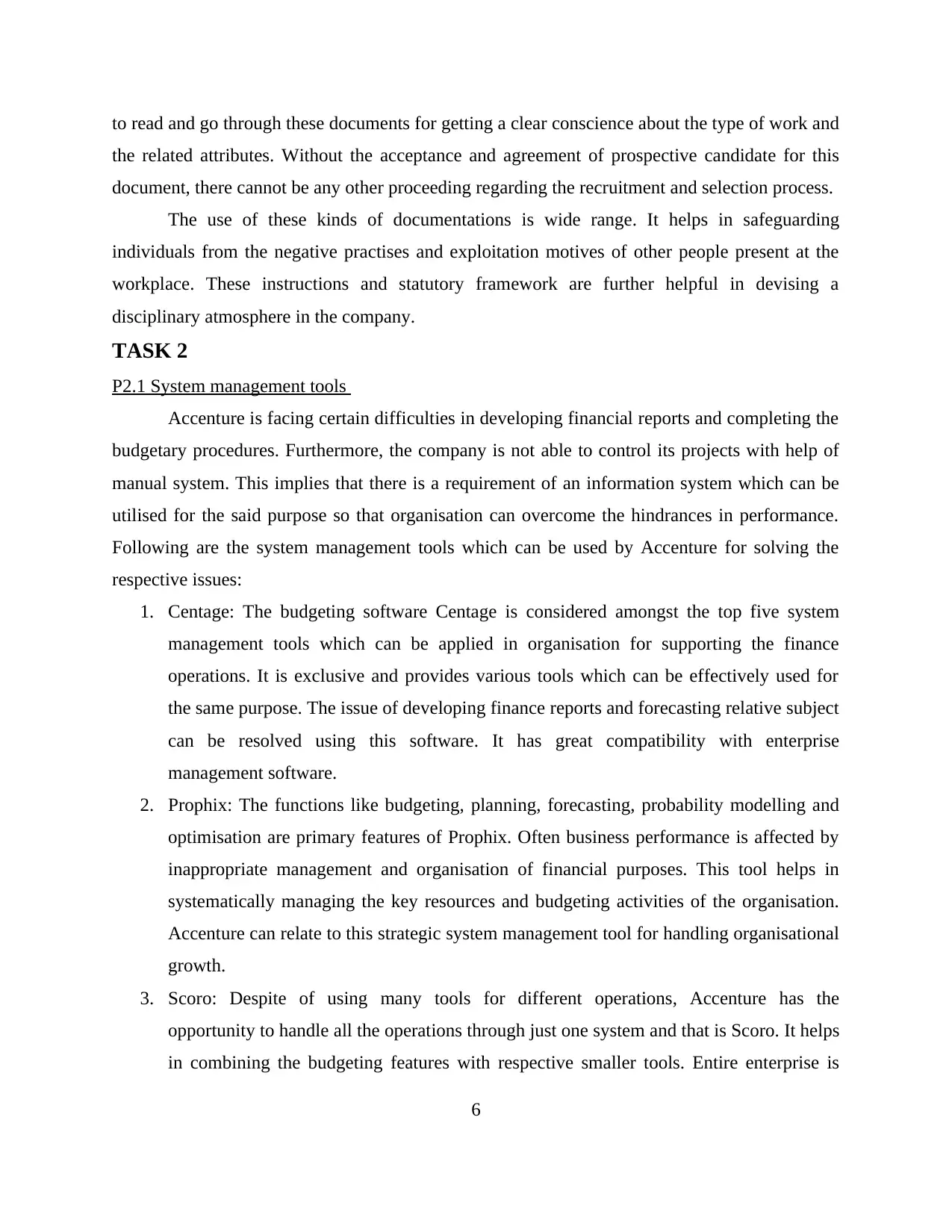
to read and go through these documents for getting a clear conscience about the type of work and
the related attributes. Without the acceptance and agreement of prospective candidate for this
document, there cannot be any other proceeding regarding the recruitment and selection process.
The use of these kinds of documentations is wide range. It helps in safeguarding
individuals from the negative practises and exploitation motives of other people present at the
workplace. These instructions and statutory framework are further helpful in devising a
disciplinary atmosphere in the company.
TASK 2
P2.1 System management tools
Accenture is facing certain difficulties in developing financial reports and completing the
budgetary procedures. Furthermore, the company is not able to control its projects with help of
manual system. This implies that there is a requirement of an information system which can be
utilised for the said purpose so that organisation can overcome the hindrances in performance.
Following are the system management tools which can be used by Accenture for solving the
respective issues:
1. Centage: The budgeting software Centage is considered amongst the top five system
management tools which can be applied in organisation for supporting the finance
operations. It is exclusive and provides various tools which can be effectively used for
the same purpose. The issue of developing finance reports and forecasting relative subject
can be resolved using this software. It has great compatibility with enterprise
management software.
2. Prophix: The functions like budgeting, planning, forecasting, probability modelling and
optimisation are primary features of Prophix. Often business performance is affected by
inappropriate management and organisation of financial purposes. This tool helps in
systematically managing the key resources and budgeting activities of the organisation.
Accenture can relate to this strategic system management tool for handling organisational
growth.
3. Scoro: Despite of using many tools for different operations, Accenture has the
opportunity to handle all the operations through just one system and that is Scoro. It helps
in combining the budgeting features with respective smaller tools. Entire enterprise is
6
the related attributes. Without the acceptance and agreement of prospective candidate for this
document, there cannot be any other proceeding regarding the recruitment and selection process.
The use of these kinds of documentations is wide range. It helps in safeguarding
individuals from the negative practises and exploitation motives of other people present at the
workplace. These instructions and statutory framework are further helpful in devising a
disciplinary atmosphere in the company.
TASK 2
P2.1 System management tools
Accenture is facing certain difficulties in developing financial reports and completing the
budgetary procedures. Furthermore, the company is not able to control its projects with help of
manual system. This implies that there is a requirement of an information system which can be
utilised for the said purpose so that organisation can overcome the hindrances in performance.
Following are the system management tools which can be used by Accenture for solving the
respective issues:
1. Centage: The budgeting software Centage is considered amongst the top five system
management tools which can be applied in organisation for supporting the finance
operations. It is exclusive and provides various tools which can be effectively used for
the same purpose. The issue of developing finance reports and forecasting relative subject
can be resolved using this software. It has great compatibility with enterprise
management software.
2. Prophix: The functions like budgeting, planning, forecasting, probability modelling and
optimisation are primary features of Prophix. Often business performance is affected by
inappropriate management and organisation of financial purposes. This tool helps in
systematically managing the key resources and budgeting activities of the organisation.
Accenture can relate to this strategic system management tool for handling organisational
growth.
3. Scoro: Despite of using many tools for different operations, Accenture has the
opportunity to handle all the operations through just one system and that is Scoro. It helps
in combining the budgeting features with respective smaller tools. Entire enterprise is
6
⊘ This is a preview!⊘
Do you want full access?
Subscribe today to unlock all pages.

Trusted by 1+ million students worldwide
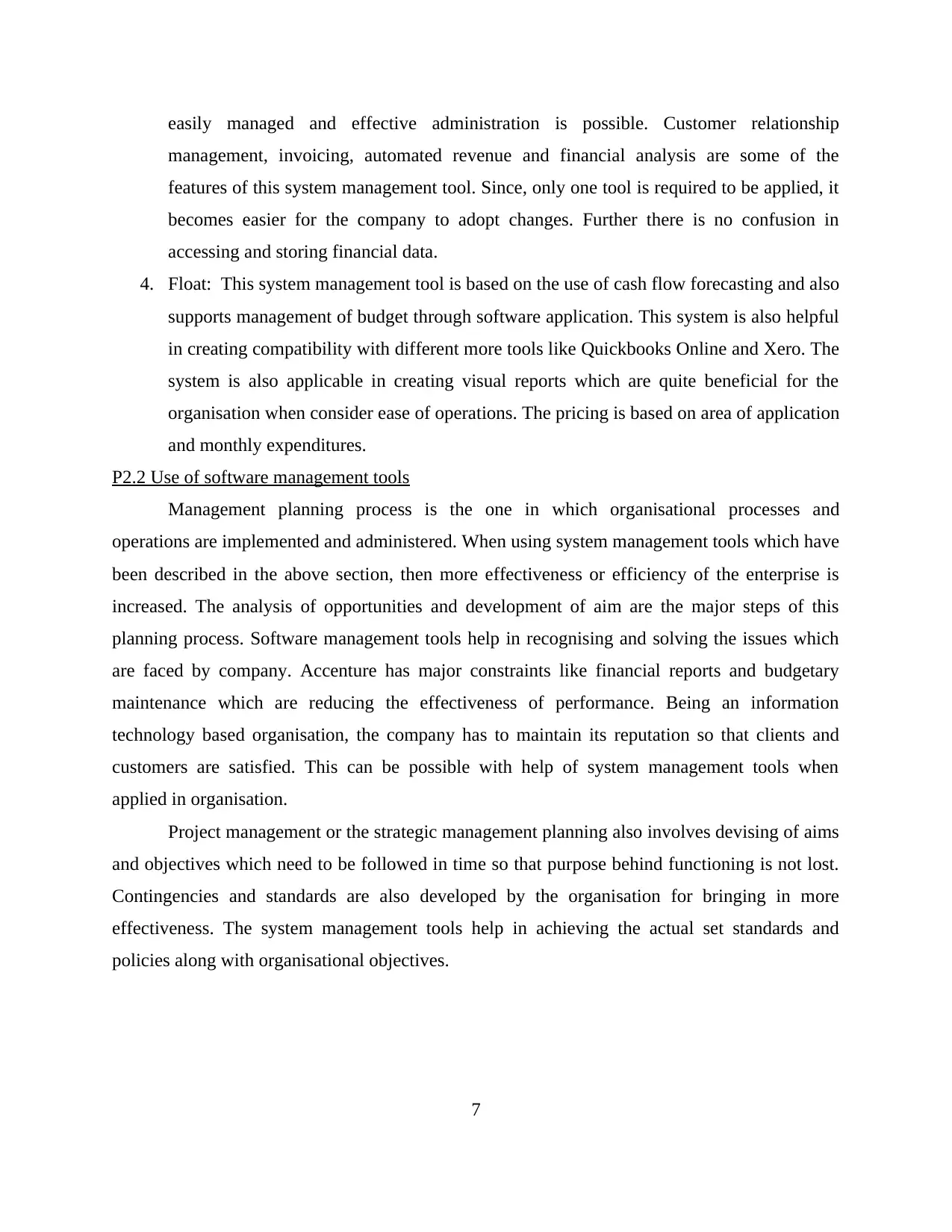
easily managed and effective administration is possible. Customer relationship
management, invoicing, automated revenue and financial analysis are some of the
features of this system management tool. Since, only one tool is required to be applied, it
becomes easier for the company to adopt changes. Further there is no confusion in
accessing and storing financial data.
4. Float: This system management tool is based on the use of cash flow forecasting and also
supports management of budget through software application. This system is also helpful
in creating compatibility with different more tools like Quickbooks Online and Xero. The
system is also applicable in creating visual reports which are quite beneficial for the
organisation when consider ease of operations. The pricing is based on area of application
and monthly expenditures.
P2.2 Use of software management tools
Management planning process is the one in which organisational processes and
operations are implemented and administered. When using system management tools which have
been described in the above section, then more effectiveness or efficiency of the enterprise is
increased. The analysis of opportunities and development of aim are the major steps of this
planning process. Software management tools help in recognising and solving the issues which
are faced by company. Accenture has major constraints like financial reports and budgetary
maintenance which are reducing the effectiveness of performance. Being an information
technology based organisation, the company has to maintain its reputation so that clients and
customers are satisfied. This can be possible with help of system management tools when
applied in organisation.
Project management or the strategic management planning also involves devising of aims
and objectives which need to be followed in time so that purpose behind functioning is not lost.
Contingencies and standards are also developed by the organisation for bringing in more
effectiveness. The system management tools help in achieving the actual set standards and
policies along with organisational objectives.
7
management, invoicing, automated revenue and financial analysis are some of the
features of this system management tool. Since, only one tool is required to be applied, it
becomes easier for the company to adopt changes. Further there is no confusion in
accessing and storing financial data.
4. Float: This system management tool is based on the use of cash flow forecasting and also
supports management of budget through software application. This system is also helpful
in creating compatibility with different more tools like Quickbooks Online and Xero. The
system is also applicable in creating visual reports which are quite beneficial for the
organisation when consider ease of operations. The pricing is based on area of application
and monthly expenditures.
P2.2 Use of software management tools
Management planning process is the one in which organisational processes and
operations are implemented and administered. When using system management tools which have
been described in the above section, then more effectiveness or efficiency of the enterprise is
increased. The analysis of opportunities and development of aim are the major steps of this
planning process. Software management tools help in recognising and solving the issues which
are faced by company. Accenture has major constraints like financial reports and budgetary
maintenance which are reducing the effectiveness of performance. Being an information
technology based organisation, the company has to maintain its reputation so that clients and
customers are satisfied. This can be possible with help of system management tools when
applied in organisation.
Project management or the strategic management planning also involves devising of aims
and objectives which need to be followed in time so that purpose behind functioning is not lost.
Contingencies and standards are also developed by the organisation for bringing in more
effectiveness. The system management tools help in achieving the actual set standards and
policies along with organisational objectives.
7
Paraphrase This Document
Need a fresh take? Get an instant paraphrase of this document with our AI Paraphraser
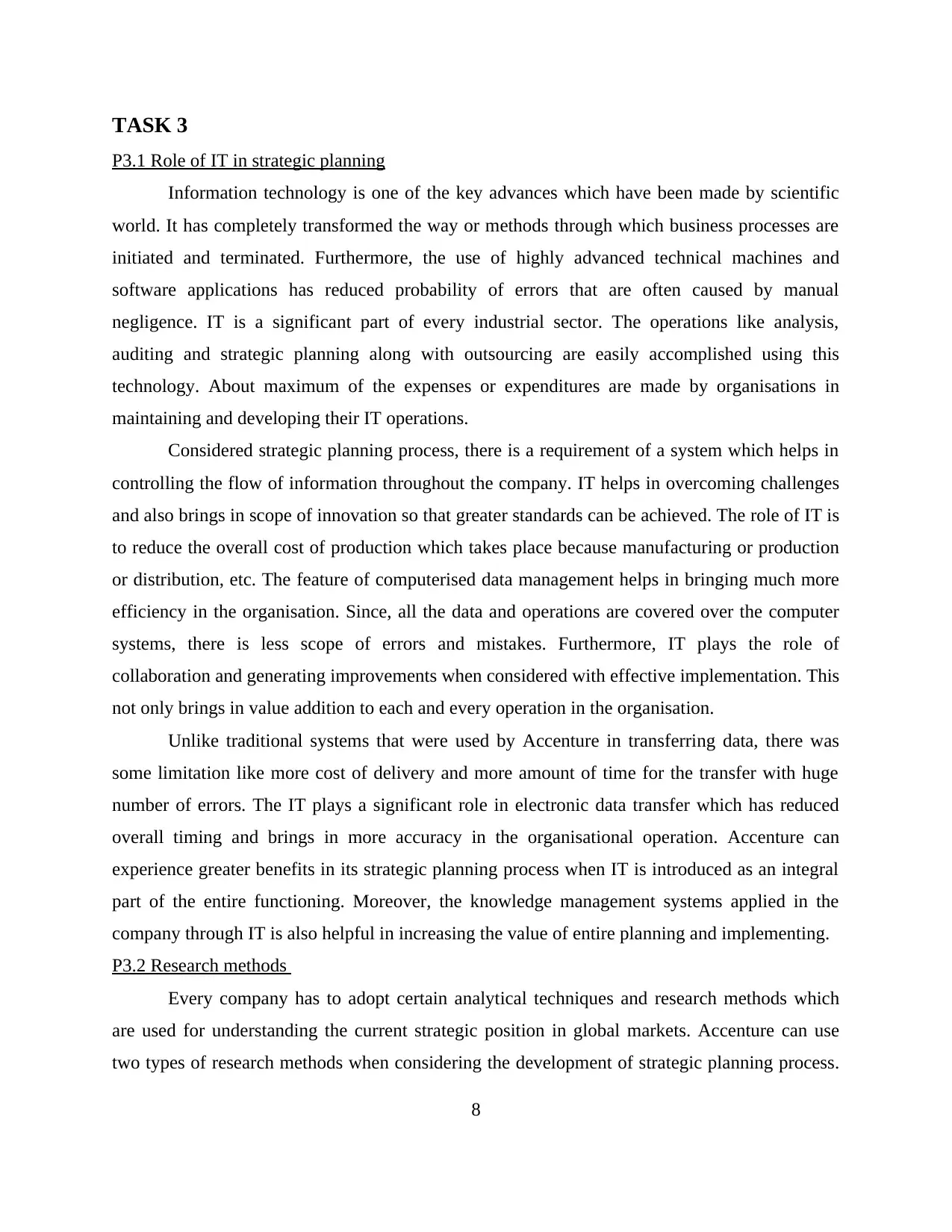
TASK 3
P3.1 Role of IT in strategic planning
Information technology is one of the key advances which have been made by scientific
world. It has completely transformed the way or methods through which business processes are
initiated and terminated. Furthermore, the use of highly advanced technical machines and
software applications has reduced probability of errors that are often caused by manual
negligence. IT is a significant part of every industrial sector. The operations like analysis,
auditing and strategic planning along with outsourcing are easily accomplished using this
technology. About maximum of the expenses or expenditures are made by organisations in
maintaining and developing their IT operations.
Considered strategic planning process, there is a requirement of a system which helps in
controlling the flow of information throughout the company. IT helps in overcoming challenges
and also brings in scope of innovation so that greater standards can be achieved. The role of IT is
to reduce the overall cost of production which takes place because manufacturing or production
or distribution, etc. The feature of computerised data management helps in bringing much more
efficiency in the organisation. Since, all the data and operations are covered over the computer
systems, there is less scope of errors and mistakes. Furthermore, IT plays the role of
collaboration and generating improvements when considered with effective implementation. This
not only brings in value addition to each and every operation in the organisation.
Unlike traditional systems that were used by Accenture in transferring data, there was
some limitation like more cost of delivery and more amount of time for the transfer with huge
number of errors. The IT plays a significant role in electronic data transfer which has reduced
overall timing and brings in more accuracy in the organisational operation. Accenture can
experience greater benefits in its strategic planning process when IT is introduced as an integral
part of the entire functioning. Moreover, the knowledge management systems applied in the
company through IT is also helpful in increasing the value of entire planning and implementing.
P3.2 Research methods
Every company has to adopt certain analytical techniques and research methods which
are used for understanding the current strategic position in global markets. Accenture can use
two types of research methods when considering the development of strategic planning process.
8
P3.1 Role of IT in strategic planning
Information technology is one of the key advances which have been made by scientific
world. It has completely transformed the way or methods through which business processes are
initiated and terminated. Furthermore, the use of highly advanced technical machines and
software applications has reduced probability of errors that are often caused by manual
negligence. IT is a significant part of every industrial sector. The operations like analysis,
auditing and strategic planning along with outsourcing are easily accomplished using this
technology. About maximum of the expenses or expenditures are made by organisations in
maintaining and developing their IT operations.
Considered strategic planning process, there is a requirement of a system which helps in
controlling the flow of information throughout the company. IT helps in overcoming challenges
and also brings in scope of innovation so that greater standards can be achieved. The role of IT is
to reduce the overall cost of production which takes place because manufacturing or production
or distribution, etc. The feature of computerised data management helps in bringing much more
efficiency in the organisation. Since, all the data and operations are covered over the computer
systems, there is less scope of errors and mistakes. Furthermore, IT plays the role of
collaboration and generating improvements when considered with effective implementation. This
not only brings in value addition to each and every operation in the organisation.
Unlike traditional systems that were used by Accenture in transferring data, there was
some limitation like more cost of delivery and more amount of time for the transfer with huge
number of errors. The IT plays a significant role in electronic data transfer which has reduced
overall timing and brings in more accuracy in the organisational operation. Accenture can
experience greater benefits in its strategic planning process when IT is introduced as an integral
part of the entire functioning. Moreover, the knowledge management systems applied in the
company through IT is also helpful in increasing the value of entire planning and implementing.
P3.2 Research methods
Every company has to adopt certain analytical techniques and research methods which
are used for understanding the current strategic position in global markets. Accenture can use
two types of research methods when considering the development of strategic planning process.
8
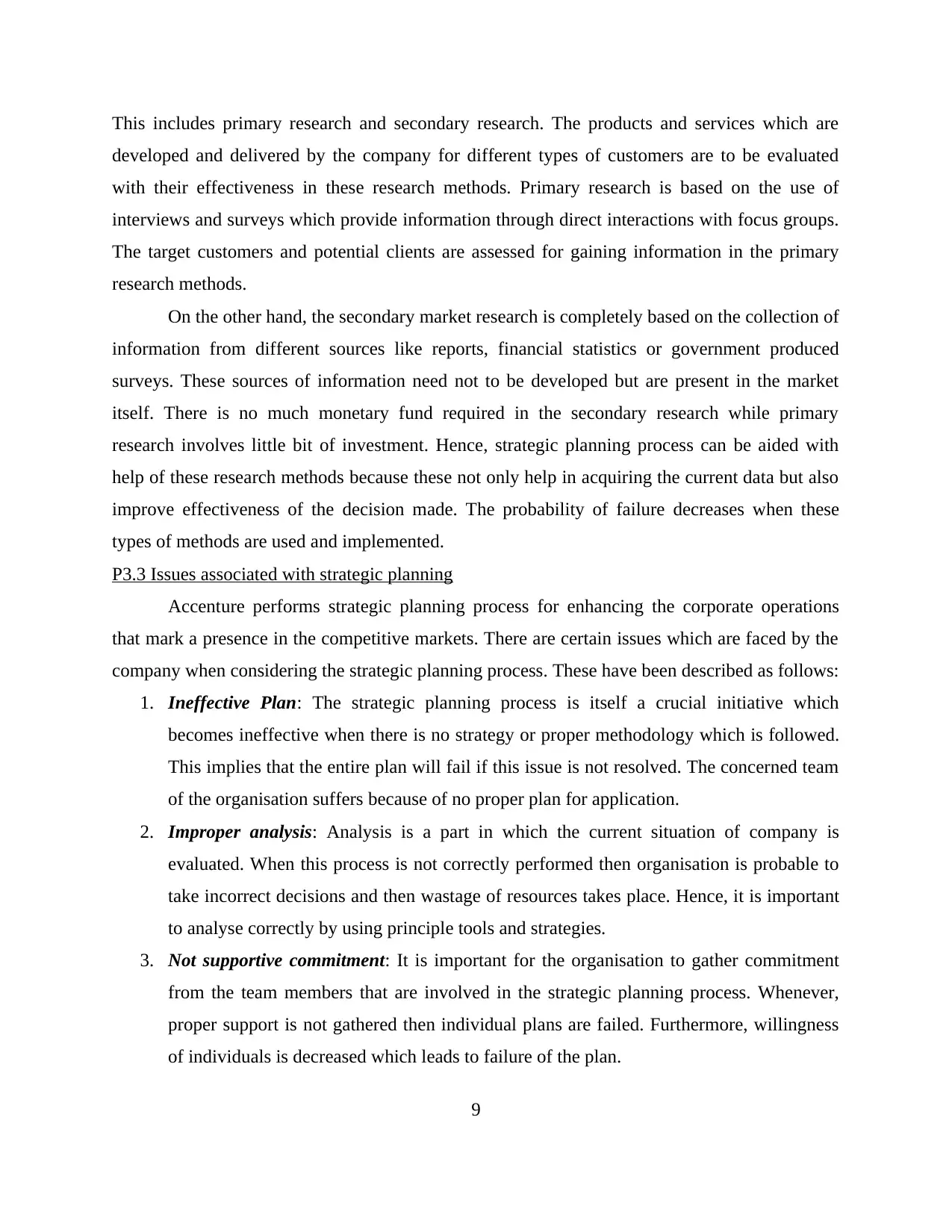
This includes primary research and secondary research. The products and services which are
developed and delivered by the company for different types of customers are to be evaluated
with their effectiveness in these research methods. Primary research is based on the use of
interviews and surveys which provide information through direct interactions with focus groups.
The target customers and potential clients are assessed for gaining information in the primary
research methods.
On the other hand, the secondary market research is completely based on the collection of
information from different sources like reports, financial statistics or government produced
surveys. These sources of information need not to be developed but are present in the market
itself. There is no much monetary fund required in the secondary research while primary
research involves little bit of investment. Hence, strategic planning process can be aided with
help of these research methods because these not only help in acquiring the current data but also
improve effectiveness of the decision made. The probability of failure decreases when these
types of methods are used and implemented.
P3.3 Issues associated with strategic planning
Accenture performs strategic planning process for enhancing the corporate operations
that mark a presence in the competitive markets. There are certain issues which are faced by the
company when considering the strategic planning process. These have been described as follows:
1. Ineffective Plan: The strategic planning process is itself a crucial initiative which
becomes ineffective when there is no strategy or proper methodology which is followed.
This implies that the entire plan will fail if this issue is not resolved. The concerned team
of the organisation suffers because of no proper plan for application.
2. Improper analysis: Analysis is a part in which the current situation of company is
evaluated. When this process is not correctly performed then organisation is probable to
take incorrect decisions and then wastage of resources takes place. Hence, it is important
to analyse correctly by using principle tools and strategies.
3. Not supportive commitment: It is important for the organisation to gather commitment
from the team members that are involved in the strategic planning process. Whenever,
proper support is not gathered then individual plans are failed. Furthermore, willingness
of individuals is decreased which leads to failure of the plan.
9
developed and delivered by the company for different types of customers are to be evaluated
with their effectiveness in these research methods. Primary research is based on the use of
interviews and surveys which provide information through direct interactions with focus groups.
The target customers and potential clients are assessed for gaining information in the primary
research methods.
On the other hand, the secondary market research is completely based on the collection of
information from different sources like reports, financial statistics or government produced
surveys. These sources of information need not to be developed but are present in the market
itself. There is no much monetary fund required in the secondary research while primary
research involves little bit of investment. Hence, strategic planning process can be aided with
help of these research methods because these not only help in acquiring the current data but also
improve effectiveness of the decision made. The probability of failure decreases when these
types of methods are used and implemented.
P3.3 Issues associated with strategic planning
Accenture performs strategic planning process for enhancing the corporate operations
that mark a presence in the competitive markets. There are certain issues which are faced by the
company when considering the strategic planning process. These have been described as follows:
1. Ineffective Plan: The strategic planning process is itself a crucial initiative which
becomes ineffective when there is no strategy or proper methodology which is followed.
This implies that the entire plan will fail if this issue is not resolved. The concerned team
of the organisation suffers because of no proper plan for application.
2. Improper analysis: Analysis is a part in which the current situation of company is
evaluated. When this process is not correctly performed then organisation is probable to
take incorrect decisions and then wastage of resources takes place. Hence, it is important
to analyse correctly by using principle tools and strategies.
3. Not supportive commitment: It is important for the organisation to gather commitment
from the team members that are involved in the strategic planning process. Whenever,
proper support is not gathered then individual plans are failed. Furthermore, willingness
of individuals is decreased which leads to failure of the plan.
9
⊘ This is a preview!⊘
Do you want full access?
Subscribe today to unlock all pages.

Trusted by 1+ million students worldwide
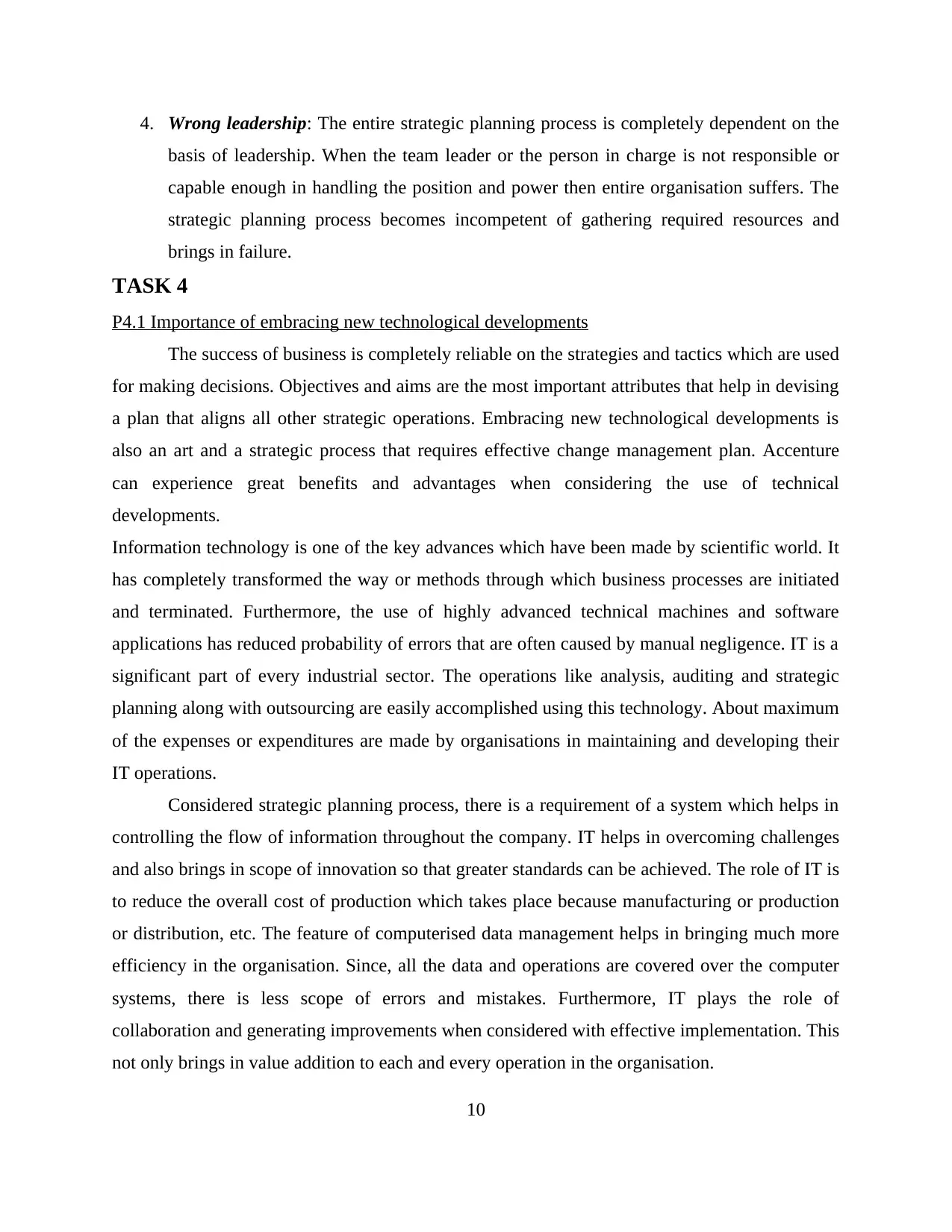
4. Wrong leadership: The entire strategic planning process is completely dependent on the
basis of leadership. When the team leader or the person in charge is not responsible or
capable enough in handling the position and power then entire organisation suffers. The
strategic planning process becomes incompetent of gathering required resources and
brings in failure.
TASK 4
P4.1 Importance of embracing new technological developments
The success of business is completely reliable on the strategies and tactics which are used
for making decisions. Objectives and aims are the most important attributes that help in devising
a plan that aligns all other strategic operations. Embracing new technological developments is
also an art and a strategic process that requires effective change management plan. Accenture
can experience great benefits and advantages when considering the use of technical
developments.
Information technology is one of the key advances which have been made by scientific world. It
has completely transformed the way or methods through which business processes are initiated
and terminated. Furthermore, the use of highly advanced technical machines and software
applications has reduced probability of errors that are often caused by manual negligence. IT is a
significant part of every industrial sector. The operations like analysis, auditing and strategic
planning along with outsourcing are easily accomplished using this technology. About maximum
of the expenses or expenditures are made by organisations in maintaining and developing their
IT operations.
Considered strategic planning process, there is a requirement of a system which helps in
controlling the flow of information throughout the company. IT helps in overcoming challenges
and also brings in scope of innovation so that greater standards can be achieved. The role of IT is
to reduce the overall cost of production which takes place because manufacturing or production
or distribution, etc. The feature of computerised data management helps in bringing much more
efficiency in the organisation. Since, all the data and operations are covered over the computer
systems, there is less scope of errors and mistakes. Furthermore, IT plays the role of
collaboration and generating improvements when considered with effective implementation. This
not only brings in value addition to each and every operation in the organisation.
10
basis of leadership. When the team leader or the person in charge is not responsible or
capable enough in handling the position and power then entire organisation suffers. The
strategic planning process becomes incompetent of gathering required resources and
brings in failure.
TASK 4
P4.1 Importance of embracing new technological developments
The success of business is completely reliable on the strategies and tactics which are used
for making decisions. Objectives and aims are the most important attributes that help in devising
a plan that aligns all other strategic operations. Embracing new technological developments is
also an art and a strategic process that requires effective change management plan. Accenture
can experience great benefits and advantages when considering the use of technical
developments.
Information technology is one of the key advances which have been made by scientific world. It
has completely transformed the way or methods through which business processes are initiated
and terminated. Furthermore, the use of highly advanced technical machines and software
applications has reduced probability of errors that are often caused by manual negligence. IT is a
significant part of every industrial sector. The operations like analysis, auditing and strategic
planning along with outsourcing are easily accomplished using this technology. About maximum
of the expenses or expenditures are made by organisations in maintaining and developing their
IT operations.
Considered strategic planning process, there is a requirement of a system which helps in
controlling the flow of information throughout the company. IT helps in overcoming challenges
and also brings in scope of innovation so that greater standards can be achieved. The role of IT is
to reduce the overall cost of production which takes place because manufacturing or production
or distribution, etc. The feature of computerised data management helps in bringing much more
efficiency in the organisation. Since, all the data and operations are covered over the computer
systems, there is less scope of errors and mistakes. Furthermore, IT plays the role of
collaboration and generating improvements when considered with effective implementation. This
not only brings in value addition to each and every operation in the organisation.
10
Paraphrase This Document
Need a fresh take? Get an instant paraphrase of this document with our AI Paraphraser
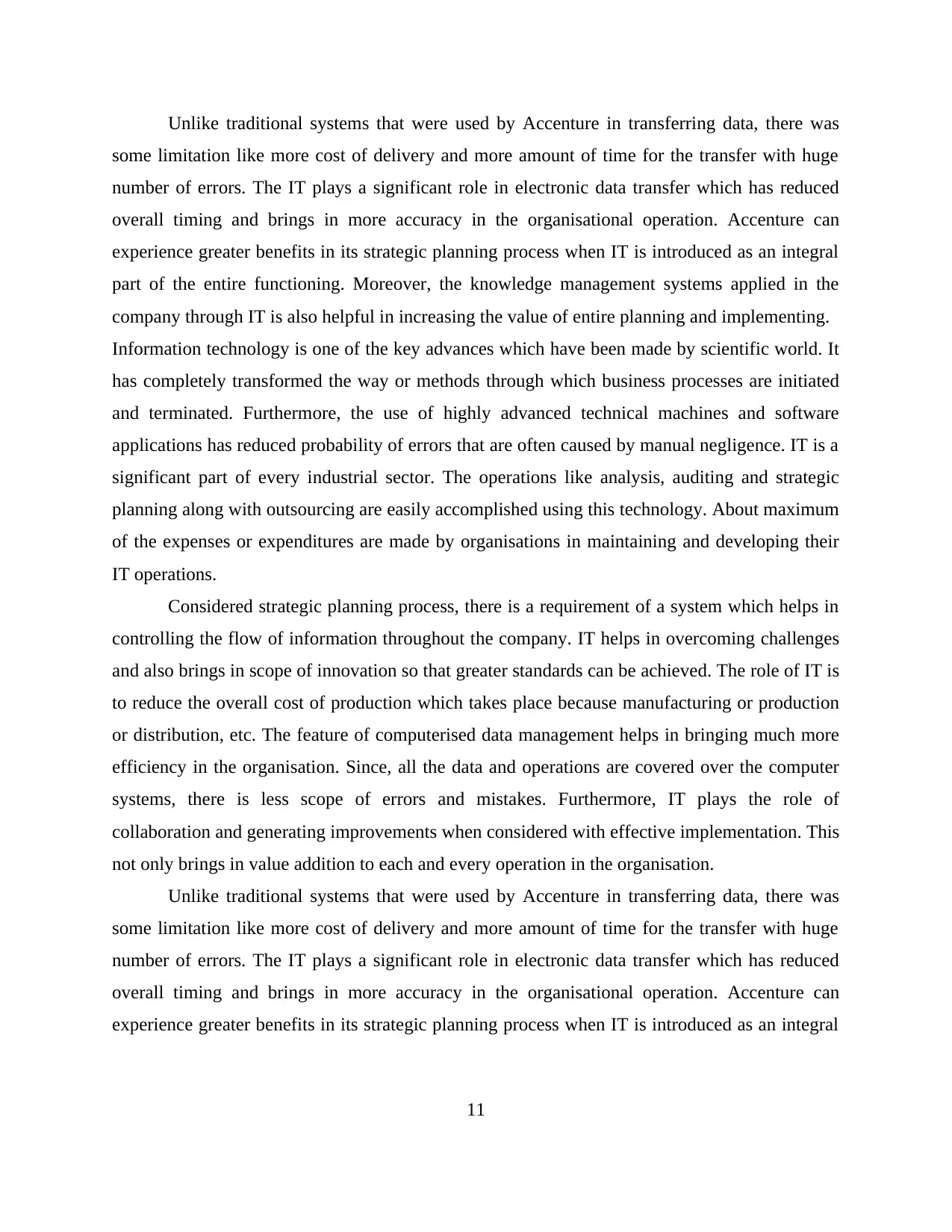
Unlike traditional systems that were used by Accenture in transferring data, there was
some limitation like more cost of delivery and more amount of time for the transfer with huge
number of errors. The IT plays a significant role in electronic data transfer which has reduced
overall timing and brings in more accuracy in the organisational operation. Accenture can
experience greater benefits in its strategic planning process when IT is introduced as an integral
part of the entire functioning. Moreover, the knowledge management systems applied in the
company through IT is also helpful in increasing the value of entire planning and implementing.
Information technology is one of the key advances which have been made by scientific world. It
has completely transformed the way or methods through which business processes are initiated
and terminated. Furthermore, the use of highly advanced technical machines and software
applications has reduced probability of errors that are often caused by manual negligence. IT is a
significant part of every industrial sector. The operations like analysis, auditing and strategic
planning along with outsourcing are easily accomplished using this technology. About maximum
of the expenses or expenditures are made by organisations in maintaining and developing their
IT operations.
Considered strategic planning process, there is a requirement of a system which helps in
controlling the flow of information throughout the company. IT helps in overcoming challenges
and also brings in scope of innovation so that greater standards can be achieved. The role of IT is
to reduce the overall cost of production which takes place because manufacturing or production
or distribution, etc. The feature of computerised data management helps in bringing much more
efficiency in the organisation. Since, all the data and operations are covered over the computer
systems, there is less scope of errors and mistakes. Furthermore, IT plays the role of
collaboration and generating improvements when considered with effective implementation. This
not only brings in value addition to each and every operation in the organisation.
Unlike traditional systems that were used by Accenture in transferring data, there was
some limitation like more cost of delivery and more amount of time for the transfer with huge
number of errors. The IT plays a significant role in electronic data transfer which has reduced
overall timing and brings in more accuracy in the organisational operation. Accenture can
experience greater benefits in its strategic planning process when IT is introduced as an integral
11
some limitation like more cost of delivery and more amount of time for the transfer with huge
number of errors. The IT plays a significant role in electronic data transfer which has reduced
overall timing and brings in more accuracy in the organisational operation. Accenture can
experience greater benefits in its strategic planning process when IT is introduced as an integral
part of the entire functioning. Moreover, the knowledge management systems applied in the
company through IT is also helpful in increasing the value of entire planning and implementing.
Information technology is one of the key advances which have been made by scientific world. It
has completely transformed the way or methods through which business processes are initiated
and terminated. Furthermore, the use of highly advanced technical machines and software
applications has reduced probability of errors that are often caused by manual negligence. IT is a
significant part of every industrial sector. The operations like analysis, auditing and strategic
planning along with outsourcing are easily accomplished using this technology. About maximum
of the expenses or expenditures are made by organisations in maintaining and developing their
IT operations.
Considered strategic planning process, there is a requirement of a system which helps in
controlling the flow of information throughout the company. IT helps in overcoming challenges
and also brings in scope of innovation so that greater standards can be achieved. The role of IT is
to reduce the overall cost of production which takes place because manufacturing or production
or distribution, etc. The feature of computerised data management helps in bringing much more
efficiency in the organisation. Since, all the data and operations are covered over the computer
systems, there is less scope of errors and mistakes. Furthermore, IT plays the role of
collaboration and generating improvements when considered with effective implementation. This
not only brings in value addition to each and every operation in the organisation.
Unlike traditional systems that were used by Accenture in transferring data, there was
some limitation like more cost of delivery and more amount of time for the transfer with huge
number of errors. The IT plays a significant role in electronic data transfer which has reduced
overall timing and brings in more accuracy in the organisational operation. Accenture can
experience greater benefits in its strategic planning process when IT is introduced as an integral
11
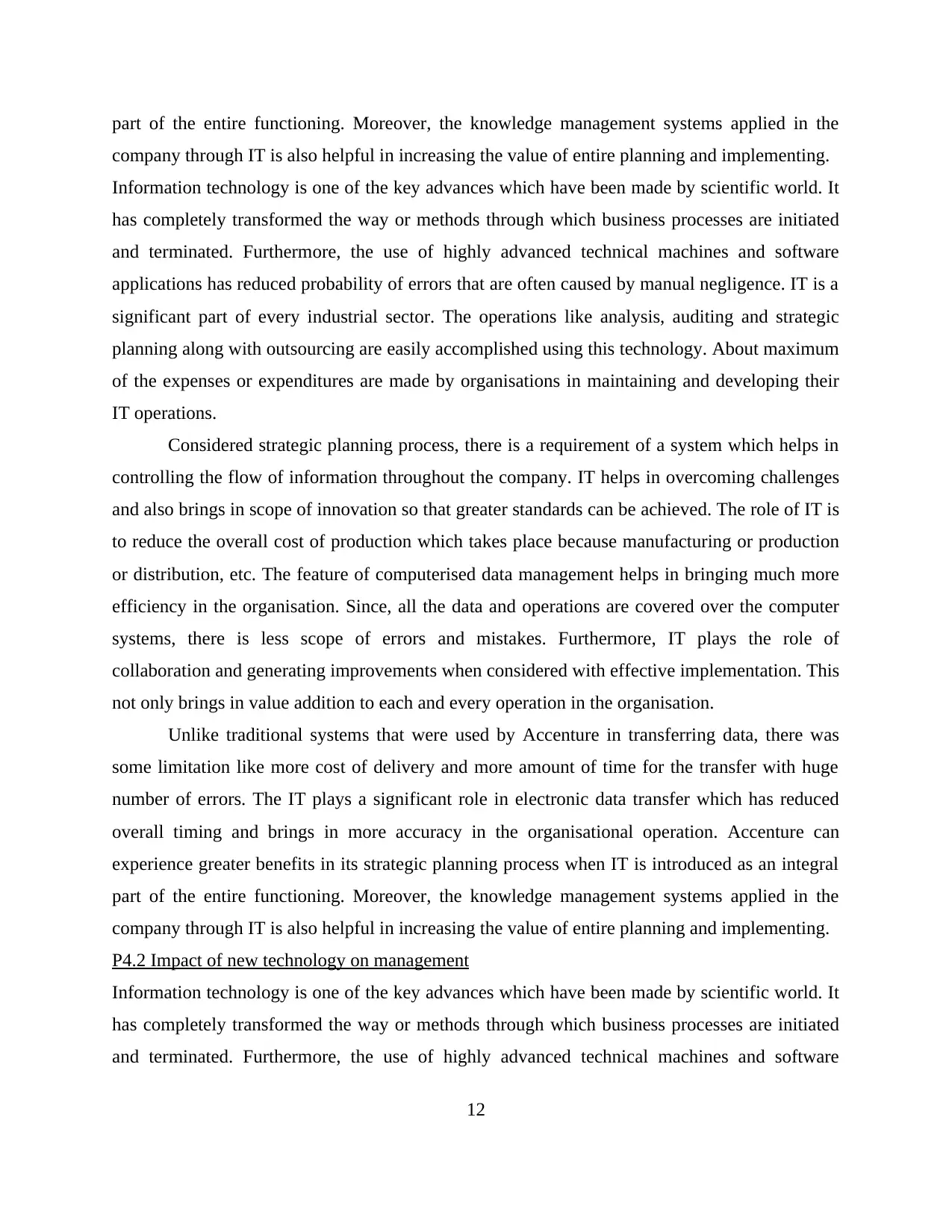
part of the entire functioning. Moreover, the knowledge management systems applied in the
company through IT is also helpful in increasing the value of entire planning and implementing.
Information technology is one of the key advances which have been made by scientific world. It
has completely transformed the way or methods through which business processes are initiated
and terminated. Furthermore, the use of highly advanced technical machines and software
applications has reduced probability of errors that are often caused by manual negligence. IT is a
significant part of every industrial sector. The operations like analysis, auditing and strategic
planning along with outsourcing are easily accomplished using this technology. About maximum
of the expenses or expenditures are made by organisations in maintaining and developing their
IT operations.
Considered strategic planning process, there is a requirement of a system which helps in
controlling the flow of information throughout the company. IT helps in overcoming challenges
and also brings in scope of innovation so that greater standards can be achieved. The role of IT is
to reduce the overall cost of production which takes place because manufacturing or production
or distribution, etc. The feature of computerised data management helps in bringing much more
efficiency in the organisation. Since, all the data and operations are covered over the computer
systems, there is less scope of errors and mistakes. Furthermore, IT plays the role of
collaboration and generating improvements when considered with effective implementation. This
not only brings in value addition to each and every operation in the organisation.
Unlike traditional systems that were used by Accenture in transferring data, there was
some limitation like more cost of delivery and more amount of time for the transfer with huge
number of errors. The IT plays a significant role in electronic data transfer which has reduced
overall timing and brings in more accuracy in the organisational operation. Accenture can
experience greater benefits in its strategic planning process when IT is introduced as an integral
part of the entire functioning. Moreover, the knowledge management systems applied in the
company through IT is also helpful in increasing the value of entire planning and implementing.
P4.2 Impact of new technology on management
Information technology is one of the key advances which have been made by scientific world. It
has completely transformed the way or methods through which business processes are initiated
and terminated. Furthermore, the use of highly advanced technical machines and software
12
company through IT is also helpful in increasing the value of entire planning and implementing.
Information technology is one of the key advances which have been made by scientific world. It
has completely transformed the way or methods through which business processes are initiated
and terminated. Furthermore, the use of highly advanced technical machines and software
applications has reduced probability of errors that are often caused by manual negligence. IT is a
significant part of every industrial sector. The operations like analysis, auditing and strategic
planning along with outsourcing are easily accomplished using this technology. About maximum
of the expenses or expenditures are made by organisations in maintaining and developing their
IT operations.
Considered strategic planning process, there is a requirement of a system which helps in
controlling the flow of information throughout the company. IT helps in overcoming challenges
and also brings in scope of innovation so that greater standards can be achieved. The role of IT is
to reduce the overall cost of production which takes place because manufacturing or production
or distribution, etc. The feature of computerised data management helps in bringing much more
efficiency in the organisation. Since, all the data and operations are covered over the computer
systems, there is less scope of errors and mistakes. Furthermore, IT plays the role of
collaboration and generating improvements when considered with effective implementation. This
not only brings in value addition to each and every operation in the organisation.
Unlike traditional systems that were used by Accenture in transferring data, there was
some limitation like more cost of delivery and more amount of time for the transfer with huge
number of errors. The IT plays a significant role in electronic data transfer which has reduced
overall timing and brings in more accuracy in the organisational operation. Accenture can
experience greater benefits in its strategic planning process when IT is introduced as an integral
part of the entire functioning. Moreover, the knowledge management systems applied in the
company through IT is also helpful in increasing the value of entire planning and implementing.
P4.2 Impact of new technology on management
Information technology is one of the key advances which have been made by scientific world. It
has completely transformed the way or methods through which business processes are initiated
and terminated. Furthermore, the use of highly advanced technical machines and software
12
⊘ This is a preview!⊘
Do you want full access?
Subscribe today to unlock all pages.

Trusted by 1+ million students worldwide
1 out of 15
Related Documents
Your All-in-One AI-Powered Toolkit for Academic Success.
+13062052269
info@desklib.com
Available 24*7 on WhatsApp / Email
![[object Object]](/_next/static/media/star-bottom.7253800d.svg)
Unlock your academic potential
Copyright © 2020–2025 A2Z Services. All Rights Reserved. Developed and managed by ZUCOL.





